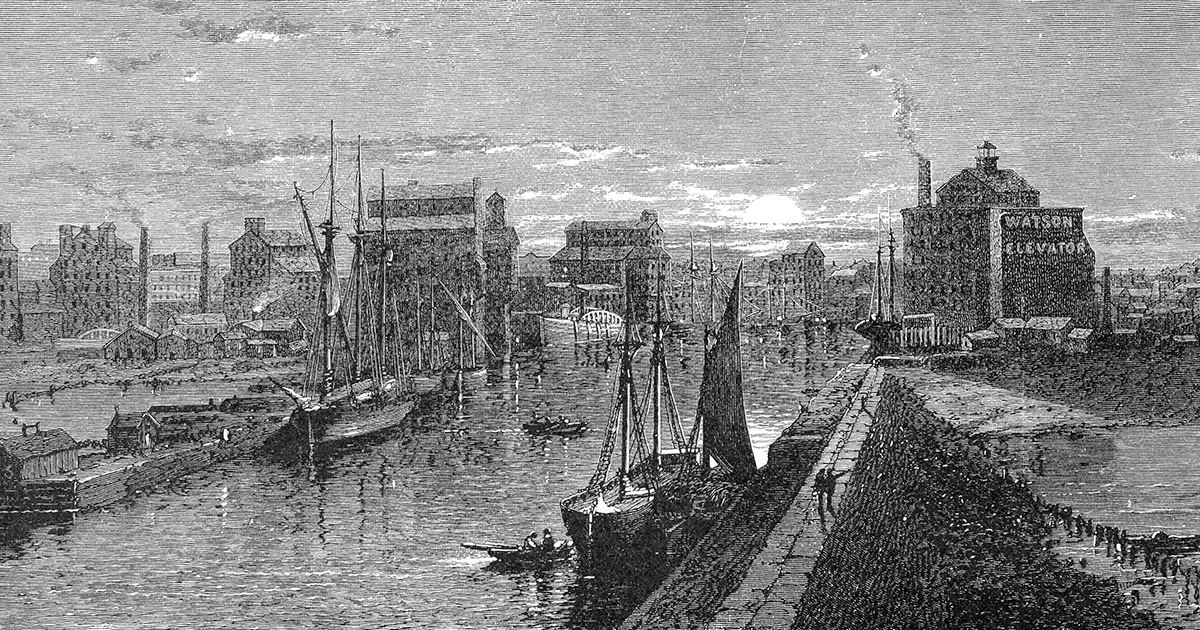
The First So-Called Dollar
The Erie Canal Medal, more formally known as the Erie Canal Completion Medallion, was issued in 1826 to celebrate the canal’s completion in 1825. It has been referred to as the first So-Called Dollar because of its design and 3.188-inch diameter. Collectors seek So-Called Dollars for their historical significance and unique designs.
Design
The Erie Canal Medal was designed by Archibald Robertson, engraved by Charles Cushing Wright, and struck in Birmingham, England, at Sir Edward Thomason’s factory.
It was issued with a small, circular wooden box that states on one side, “THIS BOX was made out of a piece of wood, brought from the Erie in the first Canal Boat,” underneath which reads “THE SENECA CHIEF.” The other side depicts an eagle from the New York coat of arms, above which reads PRESENTED BY THE CITY OF NEW YORK. Finding an Erie Canal Completion Medal with the wooden box it was issued in is uncommon today.
The medal was issued in gold and a white copper-zinc alloy. If you can find an 1826 Erie Canal Completion Medallion for sale, many have sold for around $1,000, with one selling for $9,000 at auction.
Obverse
The obverse of the Erie Canal Medal features a depiction of Pan embracing Neptune with a cornucopia of produce. This represents the flow of goods and prosperity between the Great Lakes and the Atlantic Ocean. In the background, a solitary lighthouse rests on a shore amid oceanic waves. Around the rim of the obverse reads UNION OF THE ERIE WITH THE ATLANTIC.
Reverse
On the center of the medallion is an adapted New York coat of arms depicting an eagle above a shield. Within the shield, the sun is rising. Below the shield, inscribed on a ribbon, is the word EXCELSIOR. A seascape behind the eagle and shield depicts a ship sailing from the ocean to the canal, joining the Atlantic and Great Lakes.
Around the top of the rim, it reads ERIE CANAL COMM. 4 JULY 1817 COMP. 26 OCT. 1826. On the bottom of the rim, it states the name of the engraver above the year of issue, and below that, it reads PRESENTED BY THE CITY OF N. YORK.
History of the Erie Canal
The creation of a waterway passage between the Hudson River and the Great Lakes was proposed around 1780, and a survey was conducted in 1818. In 1817, New York State Legislature authorized the construction of the canal and the $7 million price tag. Opponents of the canal and its supporter, Governor Dewitt Clinton, referred to the project as Clinton’s folly and Clinton’s ditch. When it was completed, it spanned 363 miles of wilderness and is considered one of the great engineering feats of the 19th century. This is quite an accomplishment for a canal dug entirely by men and horses.
The Erie Canal was the first canal to connect the Hudson River with the Great Lakes, effectively linking the Atlantic Ocean with North American rivers. It was built for $7 million over eight years and played a crucial role in the development of New York’s economic and cultural prosperity. The canal was especially significant in establishing New York City as a major port city and in assisting the westward expansion of the United States.
Impact of the Erie Canal
The canal’s economic impact was a major reduction in the cost of transporting goods. Before it was operational, the price to transport a barrel of flour between Rochester and Albay was $3. Using the canal, the price was reduced to a mere 75 cents. The cost of transporting some goods saw as much as a 90% reduction.
The canal was primarily intended for commercial use, but it saw more than 40,000 passengers in its first year of operation. By 1837, New York State’s $7 million construction loan had already been paid in full. It may be argued that the canal is one of the greatest reasons for the financial success of New York. It facilitated immense levels of trade, outpacing most other port cities in the United States and allowed towns like Buffalo to grow from 200 citizens in 1820 to 18,000 by 1840. Much of the trade between the U.S. and Canada following the free-trade agreement in 1854 was conducted along the waterways of the Erie Canal.
When it was constructed, most of the travelers on the Erie Canal were pulled along by mules on the adjacent road. Today, the Erie Canal is still in use, although much of it has changed over the last 120 years to accommodate larger boats.




